Abstract
OBJECTIVES: This report documents trends in functional limitations among older Americans from 1984 to 1993 and investigates reasons for such trends. METHODS: We applied logistic regression to data for noninstitutionalized Americans aged 50 years and older from the Survey of Income and Program Participation. We focused on 4 functional limitation measures unlikely to be affected by changes in role expectations and living environments: reported difficulty seeing words in a newspaper, lifting and carrying 10 pounds, climbing a flight of stairs, and walking a quarter of a mile. RESULTS: We found large declines in the crude prevalence of functional limitations, especially for those 80 years and older. Generally, changes in population composition explained only a small portion of the downward trends. Once changes in population composition and mobility-related device use were considered for difficulty walking, significant improvements in functioning remained for the 65- to 79-year-old group. CONCLUSIONS: Changes in population composition, device use, survey design, role expectations, and living environments do not appear to account completely for improvements in functioning. We infer that changes in under-lying physiological capability--whether real or perceived--likely underlie such trends.
Full text
PDF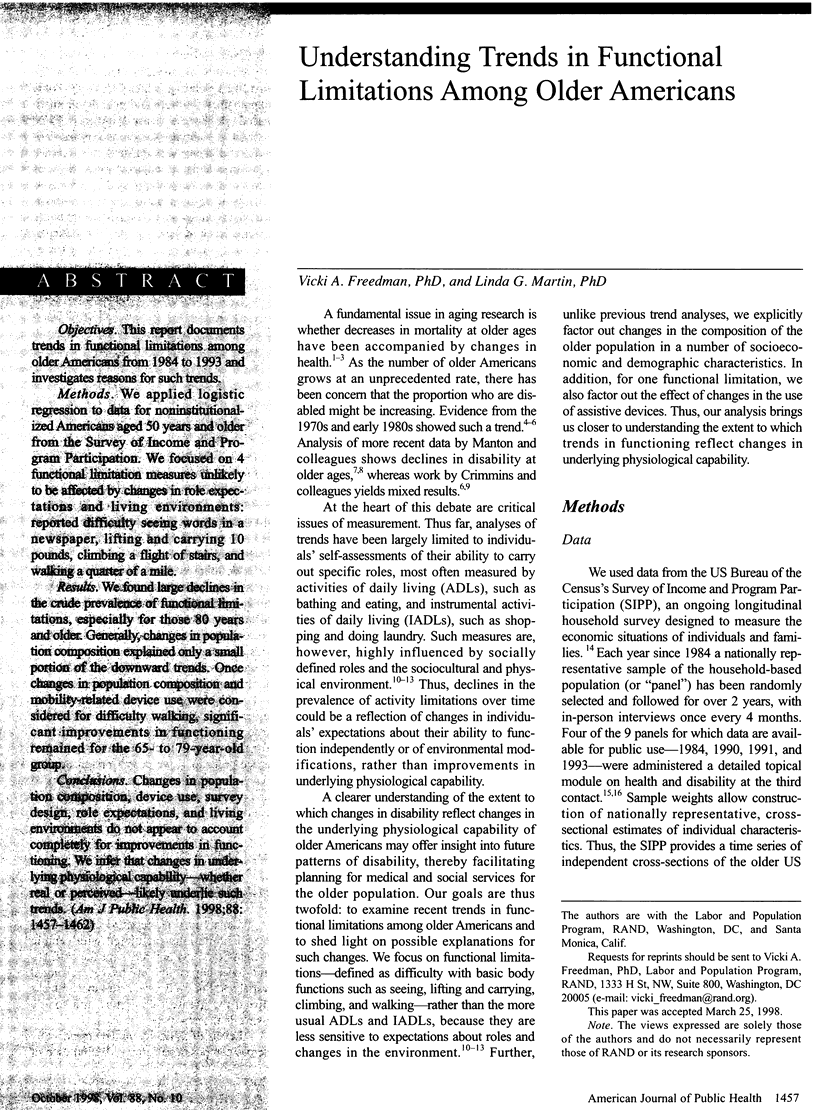
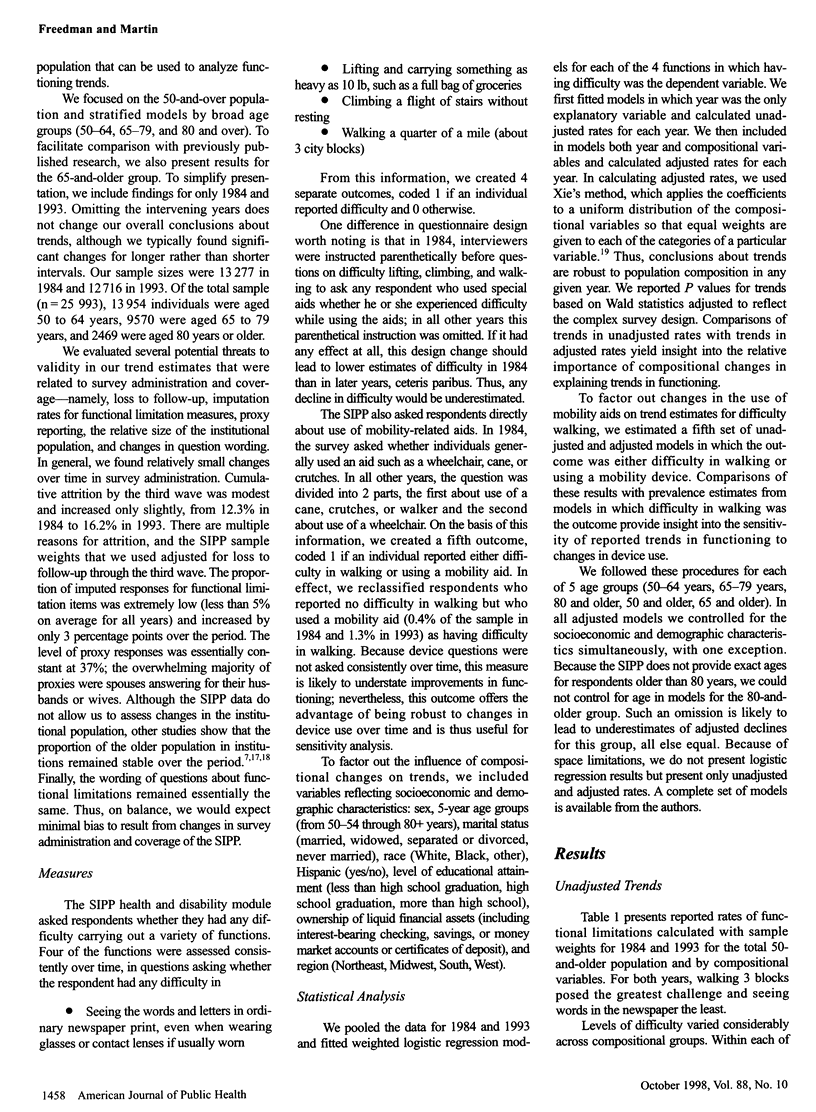
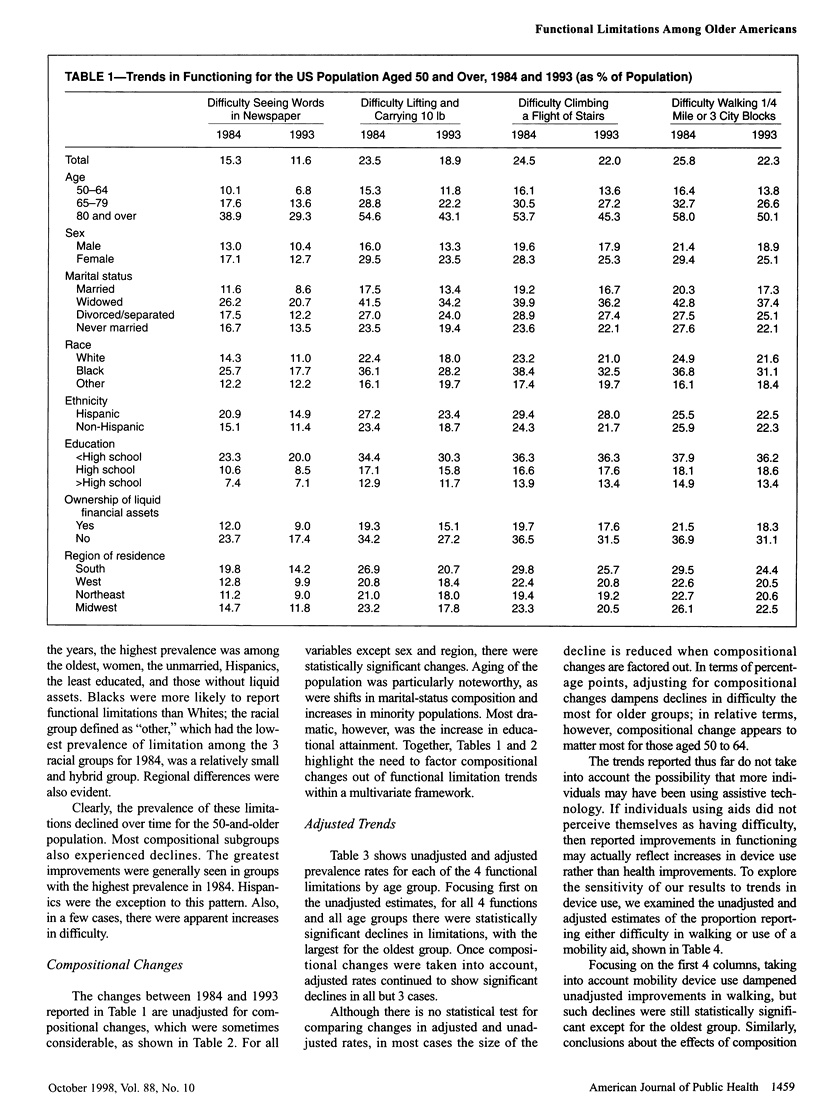
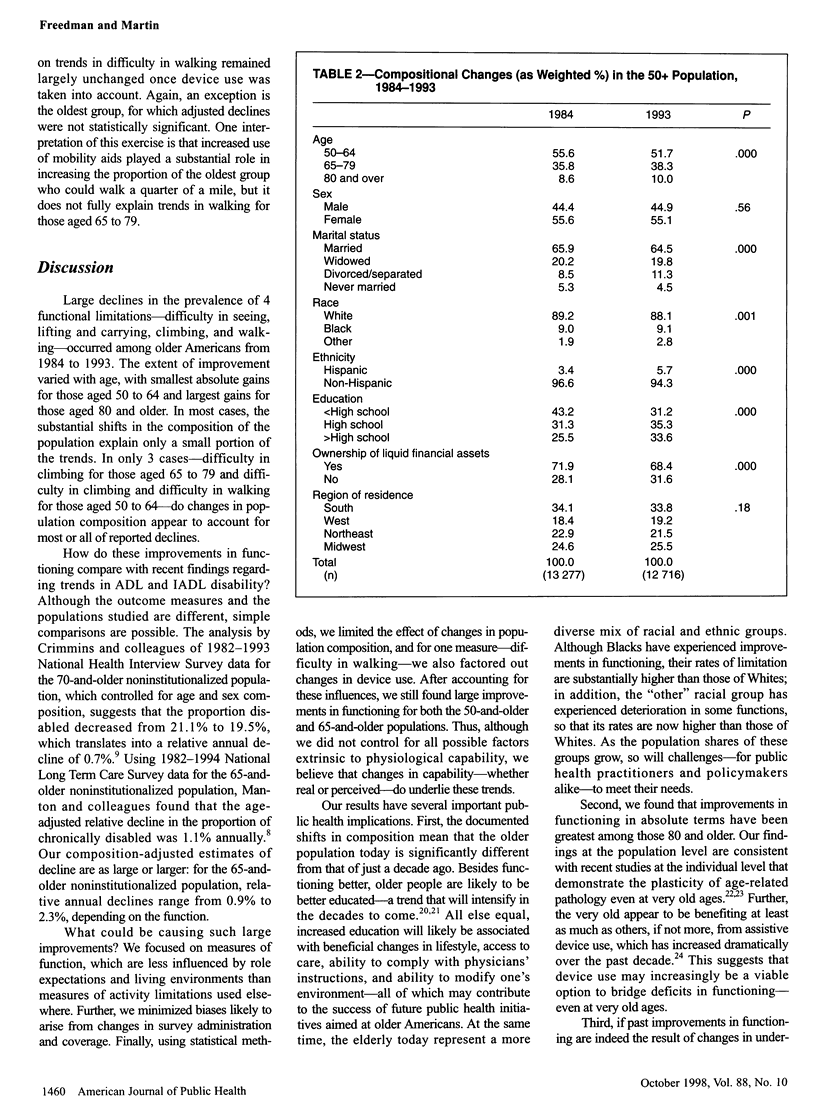
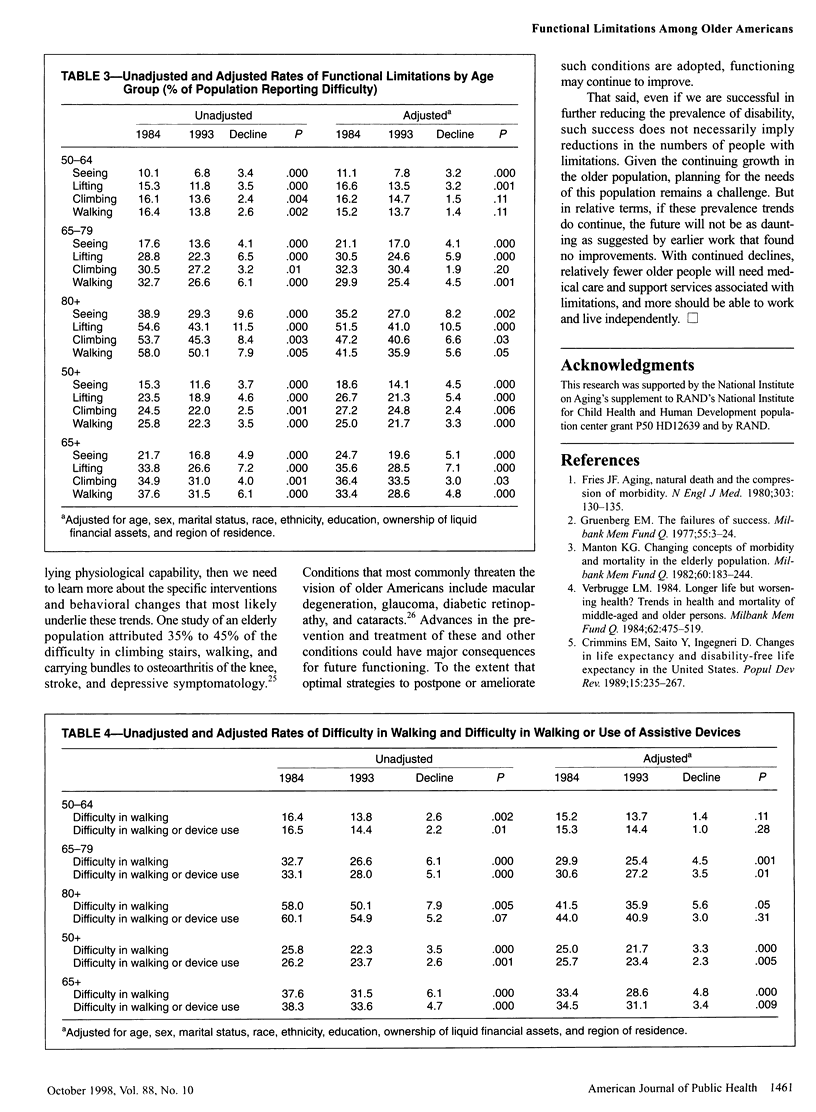
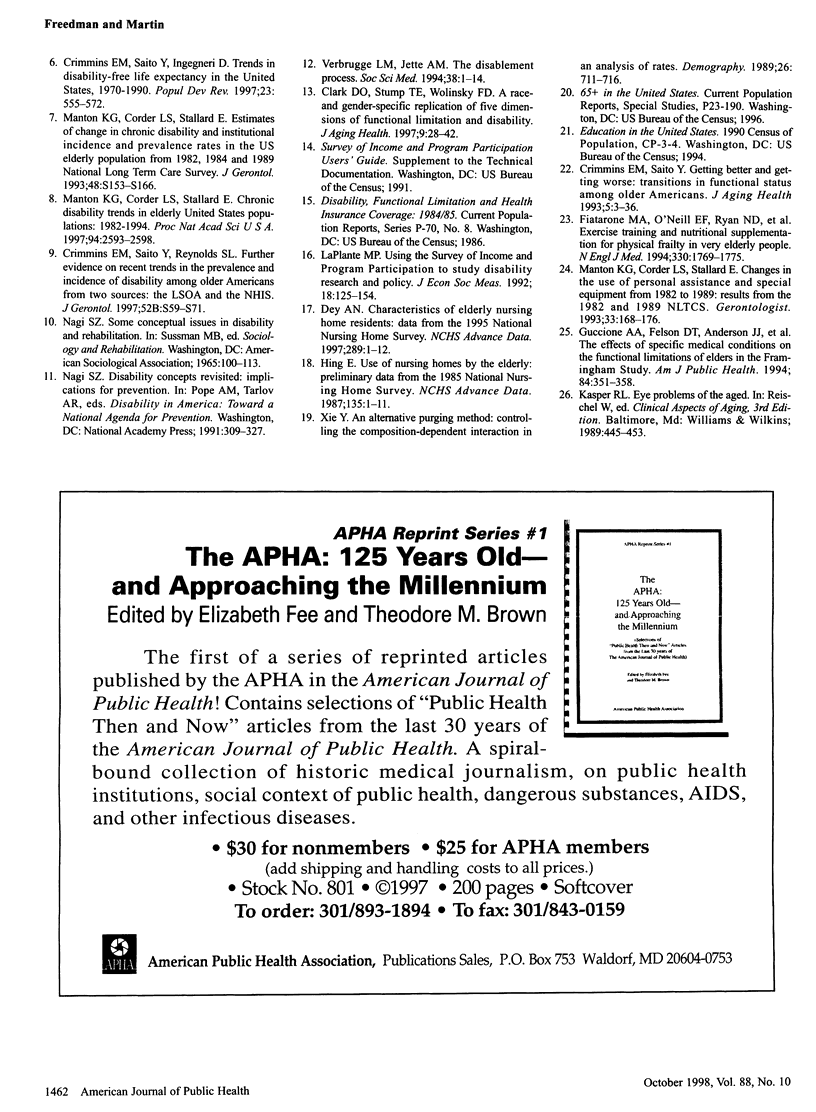
Selected References
These references are in PubMed. This may not be the complete list of references from this article.
- Clark D. O., Stump T. E., Wolinsky F. D. A race- and gender-specific replication of five dimensions of functional limitation and disability. J Aging Health. 1997 Feb;9(1):28–42. doi: 10.1177/089826439700900102. [DOI] [PubMed] [Google Scholar]
- Crimmins E. M., Saito Y., Reynolds S. L. Further evidence on recent trends in the prevalence and incidence of disability among older Americans from two sources: the LSOA and the NHIS. J Gerontol B Psychol Sci Soc Sci. 1997 Mar;52(2):S59–S71. doi: 10.1093/geronb/52b.2.s59. [DOI] [PubMed] [Google Scholar]
- Dey A. N. Characteristics of elderly nursing home residents: data from the 1995 National Nursing Home Survey. Adv Data. 1997 Jul 2;(289):1–8. [PubMed] [Google Scholar]
- Fiatarone M. A., O'Neill E. F., Ryan N. D., Clements K. M., Solares G. R., Nelson M. E., Roberts S. B., Kehayias J. J., Lipsitz L. A., Evans W. J. Exercise training and nutritional supplementation for physical frailty in very elderly people. N Engl J Med. 1994 Jun 23;330(25):1769–1775. doi: 10.1056/NEJM199406233302501. [DOI] [PubMed] [Google Scholar]
- Fries J. F. Aging, natural death, and the compression of morbidity. N Engl J Med. 1980 Jul 17;303(3):130–135. doi: 10.1056/NEJM198007173030304. [DOI] [PubMed] [Google Scholar]
- Gruenberg E. M. The failures of success. Milbank Mem Fund Q Health Soc. 1977 Winter;55(1):3–24. [PubMed] [Google Scholar]
- Guccione A. A., Felson D. T., Anderson J. J., Anthony J. M., Zhang Y., Wilson P. W., Kelly-Hayes M., Wolf P. A., Kreger B. E., Kannel W. B. The effects of specific medical conditions on the functional limitations of elders in the Framingham Study. Am J Public Health. 1994 Mar;84(3):351–358. doi: 10.2105/ajph.84.3.351. [DOI] [PMC free article] [PubMed] [Google Scholar]
- Hing E. Use of nursing homes by the elderly: preliminary data from the 1985 National Nursing Home Survey. Adv Data. 1987 May 14;(135):1–11. [PubMed] [Google Scholar]
- Manton K. G. Changing concepts of morbidity and mortality in the elderly population. Milbank Mem Fund Q Health Soc. 1982 Spring;60(2):183–244. [PubMed] [Google Scholar]
- Manton K. G., Corder L. S., Stallard E. Estimates of change in chronic disability and institutional incidence and prevalence rates in the U.S. elderly population from the 1982, 1984, and 1989 National Long Term Care Survey. J Gerontol. 1993 Jul;48(4):S153–S166. doi: 10.1093/geronj/48.4.s153. [DOI] [PubMed] [Google Scholar]
- Manton K. G., Corder L., Stallard E. Changes in the use of personal assistance and special equipment from 1982 to 1989: results from the 1982 and 1989 NLTCS. Gerontologist. 1993 Apr;33(2):168–176. doi: 10.1093/geront/33.2.168. [DOI] [PubMed] [Google Scholar]
- Manton K. G., Corder L., Stallard E. Chronic disability trends in elderly United States populations: 1982-1994. Proc Natl Acad Sci U S A. 1997 Mar 18;94(6):2593–2598. doi: 10.1073/pnas.94.6.2593. [DOI] [PMC free article] [PubMed] [Google Scholar]
- Verbrugge L. M., Jette A. M. The disablement process. Soc Sci Med. 1994 Jan;38(1):1–14. doi: 10.1016/0277-9536(94)90294-1. [DOI] [PubMed] [Google Scholar]
- Verbrugge L. M. Longer life but worsening health? Trends in health and mortality of middle-aged and older persons. Milbank Mem Fund Q Health Soc. 1984 Summer;62(3):475–519. [PubMed] [Google Scholar]
- Xie Y. An alternative purging method: controlling the composition-dependent interaction in an analysis of rates. Demography. 1989 Nov;26(4):711–716. [PubMed] [Google Scholar]


